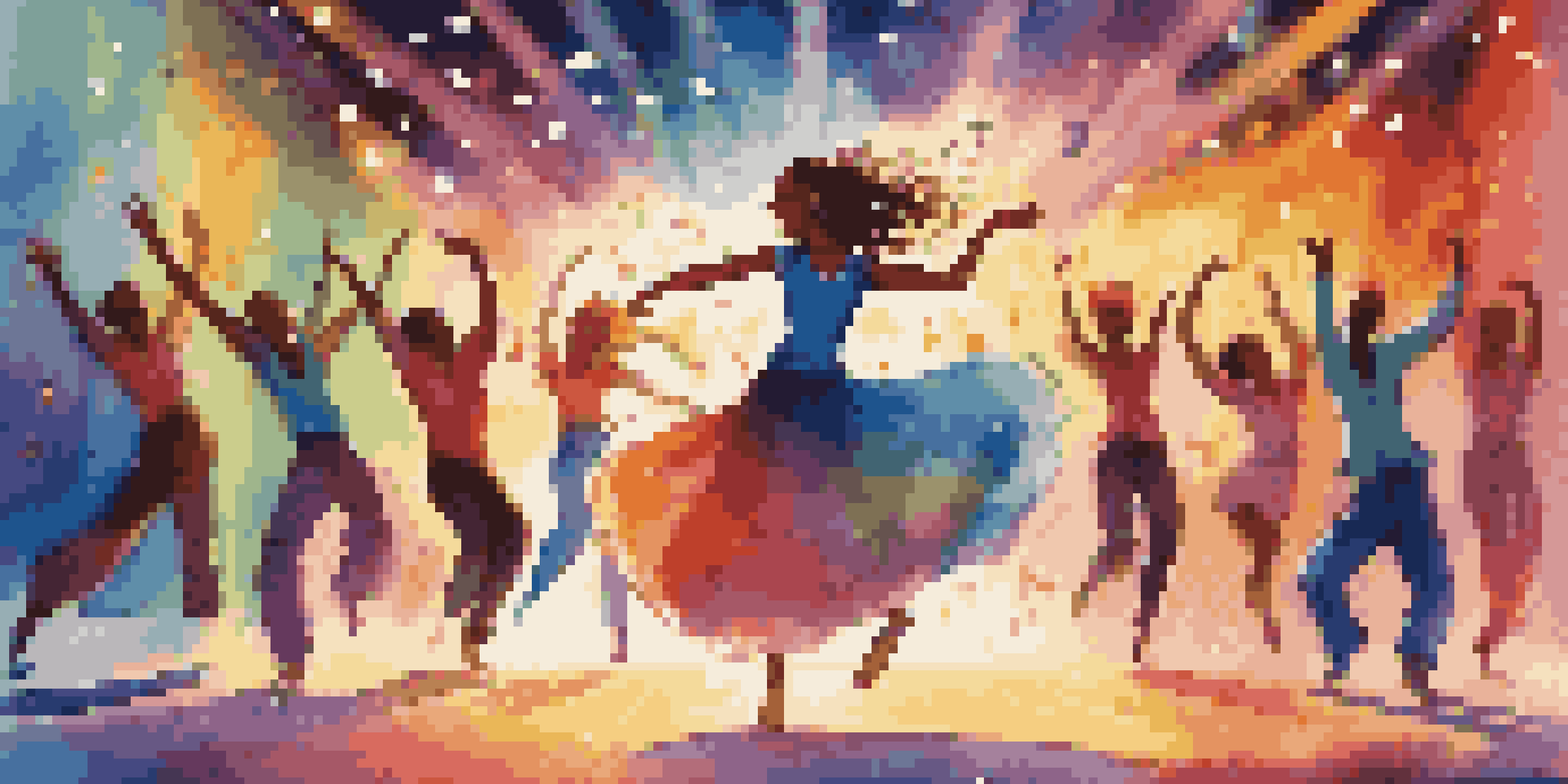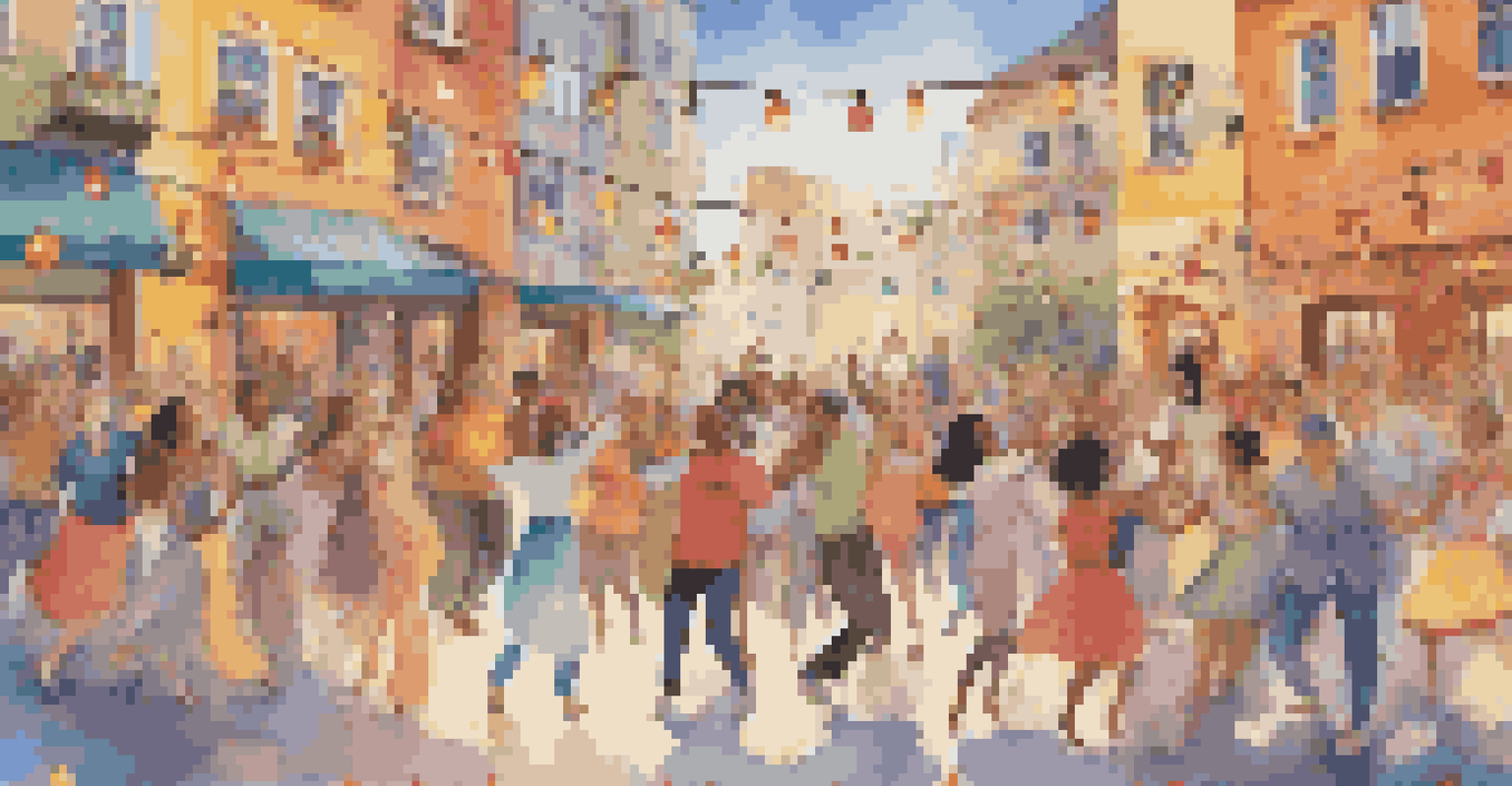Dance in Animation: A Unique Perspective on Movement

The Role of Dance in Animation: Setting the Stage
Dance in animation isn't just about movement; it's a vital storytelling tool. It helps convey emotions and character traits in a way that dialogue often cannot. Just as a dancer uses their body to express feelings, animators use movement to bring characters to life.
Dance is the hidden language of the soul.
For instance, think about Disney’s 'Frozen.' The iconic 'Let It Go' scene showcases Elsa's transformation through her dance-like movements. This not only highlights her emotional journey but also visually captivates the audience, making them feel her liberation.
By integrating dance into animated sequences, creators can craft a more immersive experience. This unique blend of art forms allows viewers to connect with characters on a deeper level, enhancing the overall impact of the story.
The Evolution of Dance in Animation: A Historical Perspective
Dance has been a part of animated films since the early days of animation. From the classic works of Walt Disney to contemporary studios, movement has evolved alongside technology. The incorporation of dance has transformed from simple, exaggerated movements to sophisticated choreography that closely mirrors real-life dance styles.

Consider the 1940 film 'Fantasia,' which beautifully combined classical music with animation, creating a mesmerizing visual dance. This film set a precedent for future projects, proving that animation could elevate dance to an art form of its own.
Dance Enhances Storytelling
Dance in animation serves as a vital storytelling tool, conveying emotions and character traits beyond what dialogue can express.
As animation technology advanced, so did the representation of dance. Today, we see a wide array of styles and techniques, from ballet to hip-hop, allowing for a diverse range of stories and characters that resonate with various audiences.
Choreography and Animation: A Perfect Partnership
Choreography in animation is not just about pretty movements; it's about creating a rhythm that syncs with the narrative. Animators often collaborate with choreographers to ensure that the dance sequences feel authentic and engaging. This partnership helps to bridge the gap between live action and animation.
Animation can give you a sense of motion and emotion that live action can't.
Take, for example, the animated film 'The Peanuts Movie.' The dance sequences reflect the characters' personalities, enhancing the storytelling. Charlie Brown's awkwardness is mirrored in his clumsy dance moves, making his character relatable and endearing.
By combining expert choreography with animation, filmmakers can craft sequences that are not only visually stunning but also emotionally resonant, drawing viewers into the characters' journeys.
Cultural Influences: Dance as a Reflection of Society
Dance styles in animation often reflect the culture they originate from, adding layers of meaning to the stories being told. For example, films like 'Coco' and 'Mulan' feature traditional dances that celebrate their respective cultures. This not only educates viewers but also fosters appreciation for diversity.
In 'Coco,' the vibrant celebration of the Day of the Dead is expressed through dance, showcasing the joy of remembrance. The animated sequences capture the lively spirit of Mexican culture, making the film both entertaining and educational.
Cultural Reflection in Animation
Animated dance styles often reflect their cultural origins, enriching narratives and fostering appreciation for diversity.
By incorporating these cultural elements, animators can create a richer narrative. Dance becomes a medium for cultural expression, allowing audiences to engage with traditions and stories from around the world.
Emotional Expression through Dance in Animation
Dance serves as a powerful tool for emotional expression in animation. Movements can convey feelings like joy, sadness, or frustration without the need for words. This visual language allows animators to create poignant moments that resonate with viewers.
A perfect example is in 'Inside Out,' where each character's movements reflect their emotional state. Joy dances exuberantly, while Sadness moves slower and more deliberately, showcasing their personalities through dance-like expressions.
This use of movement not only enhances the storytelling but also helps audiences connect with the characters on a personal level. Dance transforms emotions into a visual spectacle that transcends traditional dialogue.
The Future of Dance in Animation: What's Next?
As technology continues to advance, the possibilities for integrating dance in animation are expanding. Virtual reality and augmented reality could offer new avenues for viewers to interact with animated dance sequences in immersive ways. Imagine stepping into a dance scene and becoming part of the story!
Moreover, with the rise of digital animation tools, creators can experiment with more complex and innovative dance styles. This opens doors for unique visual storytelling that continues to push the boundaries of what animation can achieve.
Future of Dance in Animation
The integration of advanced technologies promises exciting new ways to experience dance in animation, pushing creative boundaries.
The future of dance in animation holds exciting potential, promising to deliver fresh narratives that captivate and inspire audiences. As artists explore new technologies, we can anticipate more groundbreaking ways to experience dance within animated worlds.
Conclusion: The Lasting Impact of Dance in Animation
Dance in animation is more than just entertainment; it's a profound expression of storytelling. By weaving together movement, emotion, and culture, animators create experiences that resonate with audiences of all ages. The artistry involved in animating dance sequences elevates narratives and enriches character development.
As we reflect on the evolution of dance in animation, it's clear that this art form will continue to play a significant role in shaping stories. Whether through a whimsical ballet or a powerful hip-hop routine, dance adds depth and vibrancy that captivates viewers.

In a world where storytelling is constantly evolving, the integration of dance in animation remains a timeless and impactful element, reminding us of the universal language of movement.